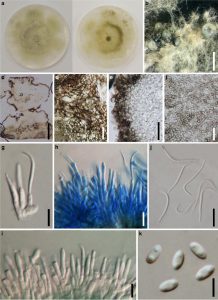Diaporthe tectonendophytica Doilom, A.J. Dissanayake & K.D. Hyde, sp. nov., Index Fungorum number: IF551975
Etymology: Name refers to its endophytic growth habit on the genus Tectona.
Holotype: MFLU 15–3537 (dry culture)
Endophytic on branches of T. grandis. Sexual morph: Undetermined. Asexual morph: on PDA, Conidiomata (250–)550–675(−1048) μm×(300–)770–1000(−1490) μm (x = 542 × 660μm, n = 25), pycnidial, scattered or aggregated, black, erumpent at maturity, subglobose or variable in shape, with an elongated black neck, with conidial mass; initially hyaline to yellowish, reddish brown to umber, becoming white to cream conidial droplets exuding from central ostioles after 20 days in light at 25 °C; pycnidial wall composed of a textura angularis and textularis intricata, comprising two cell layers, outer layer; black to dark brown, thick-walled, inner layer; hyaline, thin-walled. Conidiophores 15–36 × 1.5– 2.5μm, hyaline, branched to unbranched, cylindrical, septate, smooth, occurring in dense clusters, straight or slightly curved, rounded to obtuse at the apex, wider at base. Conidiogenous cells 4–8 × 1.5–2 μm, phialidic, cylindrical, terminal, slightly tapering towards apex. Alpha conidia (3.8–)4.8–5.4(−6) μm×1.7–2.7μm (x = 5 × 2.2μm, n=30), 1–2-guttulate, mostly bi-guttulate, hyaline, ellipsoid, apex bluntly rounded, base obtuse to subtruncate, smooth. Beta conidia (14–)24.5–25.5(−29.3) μm × 1–1.6 μm (x = 23 × 1.3 μm, n = 30), filiform, hyaline, curved or hamate, aseptate, base subtruncate. Gamma conidia Undetermined. Culture characteristics: Pure culture was isolated by subbing hyphal tips growing from surface sterilized diseased material. Colonies on PDAreaching 38–80mmdiam. after 4 days in the dark at 25 °C, (x = 52, n =5), lobate, with concentric rings of dense and sparse hyphae, irregular margin, after 10 days white (4A1) in the center, yellowish grey (4B2) in the edge from above, from below olive brown (4D4) to olive brown (4E4) at concentric rings, reaching the edge of the Petri-dish after 5–10 days.
Habitat: Asymptomatic branches of T. grandis (Doilom et al. 2017).
Known distribution: Thailand (Doilom et al. 2017).
Material examined: THAILAND, Chiang Rai Province, Muang District, on asymptomatic branches of T. grandis, 19 March 2013, M. Doilom, (MFLU 15–3537, holotype (dry–culture)), ex-type living culture MFLUCC 13–0471, MKT 113, ICMP 21174, GenBank Accession No: CAL: KU749354, ITS: KU712439, TEF1: KU749367, TUB:
KU743986.
Notes: Diaporthe tectonendophytica has been isolated as an endophyte on teak. In comparison to phylogenetically close species, the alpha conidia of D. tectonendophytica are ellipsoid, but ellipsoid to ovoid for D. longicolla whilst they are ellipsoidal or clavate in D. unshiuensis. Alpha conidia of D. tectonendophytica are shorter and wider than D. longicolla, shorter and narrower than D. unshiuensis. The multi-gene phylogeny and polymorphic nucleotides comparisons distinguish D. tectonendophytica from D. longicolla and D. unshiuensis.
FIG: Diaporthe tectonendophytica (MFLU 15–3537, holotype). a Colony on PDA after 10 days (above and below views). b Conidiomata with conidia mass sporulating on PDA after 1 month. c Section through conidioma. d Outer conidiomatal wall. e, f Peridium. g–i Conidiogenous cells with conidia developing on conidiophores. j Beta conidia. k Alpha conidia. Note: h Stained in lactophenol cotton blue. Scale bars: b = 1000 μm, c = 300μm, d–f = 20μm, g, j = 10μm, h, i, k = 5μm

